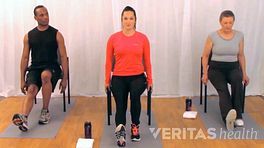Video: If My Back or Joints Hurt, Should I Work Through the Pain?
People new to exercise ball strengthening should begin by learning simple stretching and movement in order to get comfortable on the ball.
See Exercise Ball Therapy for Lower Back Pain Relief
Beginning Exercise Ball Stretches
There are several stretches that are easy to do when starting to use an exercise ball. Importantly, these stretching exercises help with proprioception, or the sense of the position or parts of the body relative to the rest of the body, and with balance.
See Stretching for Back Pain Relief
Move the hips from side-to-side:
- Keep the knees still and place hands on the knees.
- Move the hips gently from side-to-side.
- Pause for a second at the end of each sideways movement to allow for a gentle stretch.
Move hips from front-to-back:
- Sit on the exercise ball, with feet flat on the ground and shoulder-width apart. Bend knees bent at a right angle and align above the feet.
- Keep the knees still and place the hands on the knees.
- Rotate the hips forward by tucking the buttocks under the pelvis, and then push the buttocks out behind the pelvis.
The motion for the above stretches should be limited to the hip area, not the knees or chest.
Each of these stretches should be done slowly 8 to 12 times.
Beginning Exercise Ball Routines
The following two simple exercises are examples of how to use the exercise ball to help strengthen the stomach and low back muscles. Both are simple to do and are gentle on the back.
Marching on the ball is a great beginner's exercise ball routine.
Marching
- Sit on the exercise ball, as described above.
- Lift the heel of one foot off of the floor.
- Move onto the toe, eventually lifting the whole foot up in the air.
- Hold this position for one second, and place the foot back onto the floor.
- Repeat this exercise on the other side.
Notice how the stomach muscles contract to lift the foot off the floor.
The exercise ball squat is a safe, effective way to start an exercise ball routine.
Exercise ball squat
- Stand with the feet shoulder-width apart.
- Place the exercise ball against a wall and aligned with the lower back. Press the ball between the lower back and the wall.
- Move both feet out so they are slightly in front of the hips.
- Bend the knees down slightly, then up.
- Start with a small movement and hold for one or two seconds in the down position and up position.
Each of these stretches should be done slowly 8 to 12 times.
Remember, for beginners, using a slightly deflated exercise ball provides more stability than a fully inflated ball and may be more comfortable.
Work with a Physical Therapist or Other Qualified Professional
Before getting started with exercise therapy, it is recommended to work with a qualified professional, such as a physical therapist, a doctor or an exercise physiologist.
A professional can help:
- Determine an appropriate workout out routine. A professional can tailor exercise ball stretches and exercises to fit an individual’s condition and abilities. For example, an athlete may be able to perform more challenging exercises or higher repetitions of exercises than an adult who is new to exercising and has just had an epidural steroid injection for sciatica.
See Lumbar Epidural Steroid Injections for Low Back Pain and Sciatica
- Perform the exercises correctly. It is surprisingly difficult to develop and maintain the correct form during these exercises, and strengthening exercises need to be done correctly in order to be effective.
- Keep a person motivated to maintain the therapy. In order to reap the benefits of these strengthening exercises, it is necessary to do them regularly over time. Working with a professional makes the individual feel accountable.
- Determine the correct size ball. Exercise balls vary in size, typically ranging between 45cm to 85cm in height.1 Using the correct size ball is important for the exercises to be beneficial and to help prevent injury.
For beginners, just getting started with some simple, safe, and effective activities with the exercise ball is most important. After that, there is a wide range and variety of types of back exercises that can be completed on an exercise ball, depending on one's interest, ability, and back condition.
References
- 1.Sukumar S, Jayasrikanth S. Efficacy of Modified Task Oriented Exercises Performed On Swiss Ball Over Conventional Task Oriented Exercises on Improving Balance Post Stroke. International Journal of Health Sciences and Research. 2015; 5: 217-223.









